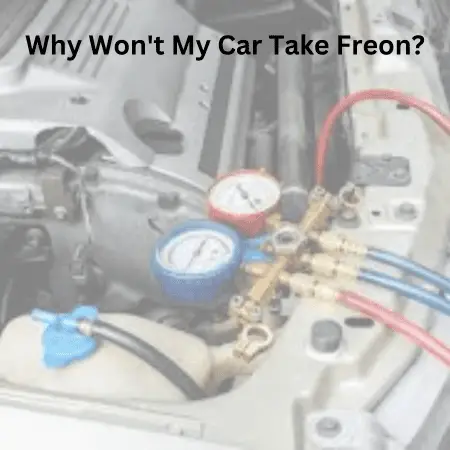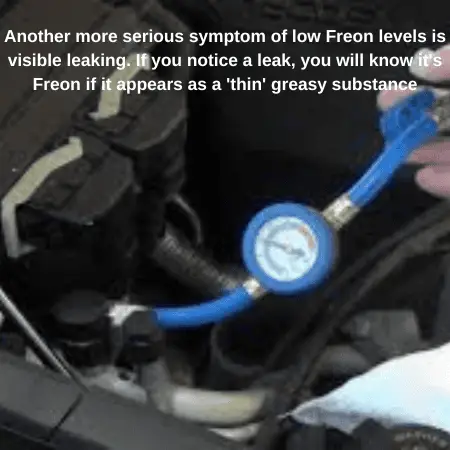If you’ve ever experienced issues with your car’s air conditioning system, you may have encountered the frustration of trying to add Freon only to find that it won’t take it. Understanding why this happens and how to address the underlying problems can save you time, money, and discomfort during the hot summer months. In this article, I will throw light on why won’t my car take freon. So keep on reading…
What is Freon?
Freon is a type of gas that’s used in things like refrigerators and air conditioners to make them cold. It’s made up of chemicals called chlorofluorocarbons, or CFCs for short. When you turn on your fridge or AC, the Freon flows through coils inside the machine. As it expands and contracts, it absorbs heat from the inside, making it cooler.
That’s how your fridge keeps your food cold or your AC cools down your room. However, it’s important to know that Freon can harm the environment if it’s released into the air because it can damage the Earth’s protective ozone layer. That’s why newer appliances use different, more environmentally friendly refrigerants.

You May Find Helpful
- Can You Drive Without a Muffler? Pros & Cons Of Removing Mufflers
- Is It Safe To Drive Without Power Steering?
- How To Clear Engine Derate? Step By Step Guide
- How To Pass Emissions With A Deleted Diesel – A complete Guide
Reasons: Why won’t my car take freon?
There are a few common reasons why your car might not take Freon:
1- Leak in the AC System:
One reason could be that there’s a leak in the air conditioning (AC) system of your car. If there’s a leak, the Freon you put in will just leak out again, so it won’t make the AC cold.
When there’s a leak in the AC system of your car, it means that the Freon, which is supposed to stay inside the system to cool the air, is escaping. Freon is a gas, and if there’s a hole or a crack in any part of the AC system – like the hoses, compressor, condenser, or evaporator – the Freon will leak out.
Now, even if you add more Freon into the system, it won’t fix the problem. That’s because the newly added Freon will just leak out again through the same hole or crack. It’s like trying to fill a bucket with a hole in it – no matter how much water you pour in, it will keep leaking out.
As a result, your car’s AC won’t cool properly because there isn’t enough Freon left in the system to do its job effectively. To solve this issue, the leak in the AC system needs to be located and repaired. Once the leak is fixed, the AC system can be recharged with the right amount of Freon, restoring its cooling capability.
2- Faulty Compressor:
Another reason could be a problem with the compressor. The compressor is what pumps the Freon through the AC system. If it’s not working properly, the Freon won’t circulate correctly, and your car won’t cool down.
The compressor in your car’s AC system is like the heart of the cooling process. Its job is to pressurize and pump the Freon gas through the system, which is crucial for the whole cooling process to work efficiently.
If the compressor is faulty, it means that it’s not doing its job properly. This could happen due to a variety of reasons:
When the compressor is faulty, it affects the circulation of Freon throughout the AC system. Without proper circulation, the Freon cannot absorb heat from inside the car and release it outside, resulting in inadequate cooling or no cooling at all.
3- Clogged Expansion Valve:
The expansion valve helps regulate the flow of Freon through the AC system. If it gets clogged or stuck, the Freon won’t be able to move properly, causing the AC to malfunction.
The expansion valve plays a critical role in your car’s AC system. Its job is to regulate the flow of refrigerant (Freon) into the evaporator coil, where it undergoes a phase change from a high-pressure liquid to a low-pressure gas. This phase change is essential for absorbing heat from the air inside your car, which cools down the interior.
When the expansion valve is clogged or stuck, it prevents the proper circulation of refrigerant through the AC system, impacting its cooling capacity. As a result, your car’s AC may exhibit symptoms such as inconsistent cooling, reduced airflow, or warm air blowing from the vents.
4- Dirty or Blocked Condenser:
The condenser is like a radiator for your AC system, helping to release heat from the Freon. If it’s dirty or blocked by debris, it can’t do its job properly, and the Freon won’t cool down as it should.
However, if the condenser becomes dirty or blocked by debris such as leaves, dirt, or insects, it can’t effectively release heat. As a result, the refrigerant remains too hot, preventing it from cooling down properly. This can lead to inefficient operation of your car’s AC system, causing it to blow warm air instead of cold.
5- Electrical Issues:
Sometimes, the problem might not be with the Freon or the AC system itself, but with the electrical components that control it. Faulty wiring or sensors could prevent the AC from working properly, even if there’s enough Freon in the system.
our car’s AC system relies on various electrical components to function correctly, including sensors, switches, relays, and wiring. If any of these components develop faults or malfunctions, it can disrupt the operation of the AC system, regardless of the amount of Freon in the system.

Troubleshooting and Solutions of Car Won’t Take Freon
Certainly! Let’s delve deeper into troubleshooting and solutions for when your car won’t take Freon:
Check for Leaks:
Troubleshooting: Inspect all components of the AC system, including hoses, connections, compressor, condenser, and evaporator, for signs of leaks. Look for oily spots, residue, or hissing sounds, which may indicate a leak.
Solution: Use a UV dye or leak detection kit to pinpoint the exact location of leaks. Repair or replace damaged components, such as worn-out hoses or corroded connections. Ensure proper sealing with new O-rings or gaskets where needed.
Inspect Compressor Operation:
Troubleshooting: Verify if the compressor is functioning properly when the AC is turned on. Listen for any abnormal noises, such as grinding or clicking, which could indicate compressor issues.
Solution: Check electrical connections, fuses, and relays associated with the compressor. Replace any faulty components and ensure proper electrical supply. If the compressor is damaged or worn out, consider repairing or replacing it to restore proper operation.
Check Refrigerant Levels:
Troubleshooting: Use a pressure gauge to check the refrigerant levels in the AC system. Low pressure may suggest a leak or insufficient refrigerant, while high pressure could indicate a blockage or overcharge.
Solution: Recharge the AC system with the appropriate amount of refrigerant (Freon) after addressing any leaks. Evacuate and recharge the system professionally if pressure issues persist. Ensure proper refrigerant type and quantity as specified by the manufacturer.
Inspect Hoses and Connections:
Troubleshooting: Examine all hoses, fittings, and connections for signs of damage, corrosion, or leaks. Pay close attention to areas where hoses meet components or connections.
Solution: Tighten loose connections and replace damaged hoses or fittings. Use quality replacement parts and ensure proper sealing with compatible O-rings or seals. Consider upgrading to reinforced hoses for increased durability.
Check Expansion Valve:
Troubleshooting: Inspect the expansion valve for any clogs, blockages, or malfunctions that could disrupt the refrigerant flow.
Solution: Clean or replace the expansion valve if it’s clogged, stuck, or not functioning correctly. Adjust the valve as per manufacturer specifications to regulate refrigerant flow effectively and maintain proper cooling performance.
Inspect Condenser:
Troubleshooting: Check the condenser for obstructions, such as dirt, debris, or blockages, which can hinder airflow and heat exchange.
Solution: Thoroughly clean the condenser to remove any accumulated dirt or debris. Use compressed air, a soft brush, or a specialized condenser cleaner for effective cleaning. Ensure unobstructed airflow through the condenser fins for optimal heat dissipation.
Verify Electrical Connections:
Troubleshooting: Ensure all electrical connections, switches, and relays related to the AC system are secure and functioning correctly.
Solution: Test electrical components for continuity, proper voltage, and signal transmission. Replace any faulty switches, relays, or wiring harnesses. Check ground connections for corrosion or poor contact, and repair as needed to ensure reliable electrical operation.
By implementing these preventive measures, you can help prolong the lifespan of your car’s AC system, maintain efficient cooling performance, and reduce the likelihood of encountering issues like difficulty in taking Freon. Regular maintenance and proactive care are key to ensuring a comfortable and reliable driving experience.
Must Read
Conclusion
Your car may not take Freon due to leaks, a faulty compressor, a clogged expansion valve, a dirty condenser, electrical issues, or overfilling. These issues can disrupt the AC system’s operation, leading to decreased cooling efficiency. Identifying and addressing these problems promptly is essential to restore proper functioning and ensure comfortable driving conditions.
